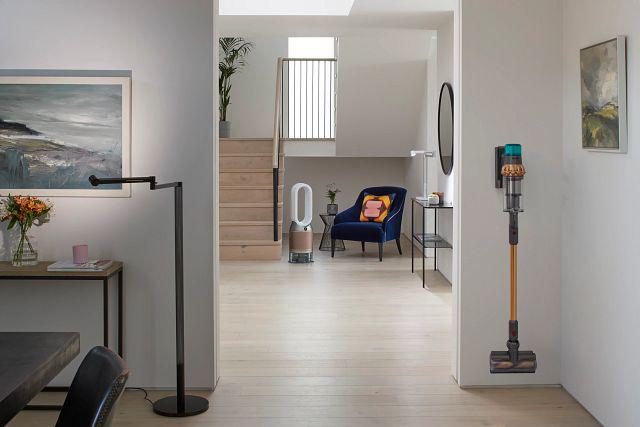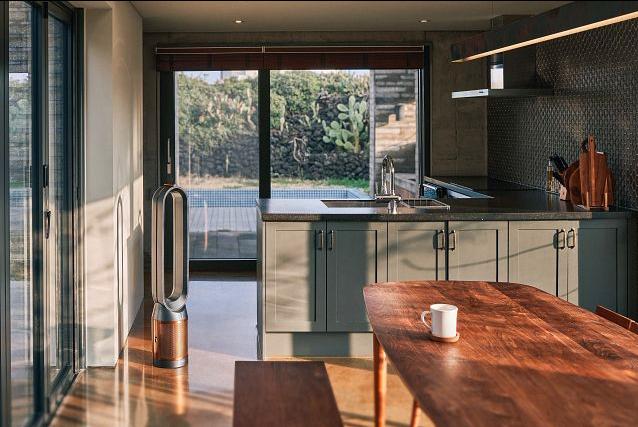Home trends to look out for in 2022
From multi-functionality to more sustainably focused spaces, our Dyson interior specialists and engineers share their predictions for healthy home trends in 2022.

Creating a multi-functional living room
With the pandemic changing the way we work, the new normal at home could mean daily work calls from the dining table, home-based learning in the kitchen, or exercising in the living room. Open plan spaces in homes have shifted to informal breakout areas to accommodate these changes. With hybrid working set to continue¹ and more family members at home, greater flexibility in home layouts will allow for various activities.
-

-
The inclusion of a wall-mounted drop leaf table as work desk in the living room, or the integration of modular furniture like sectional sofa blocks to change seating arrangements, or stackable shelving units for storage options -- will allow for the expansion and contraction of spaces. Versatile products such as the Dyson Lightcycle Morph™ will also be ideal in such spaces. The Dyson Lightcycle Morph™ has unique local daylight tracking and transforms for different uses – as an indirect, task, feature or ambient light – providing the right illumination for the user throughout the day for work calls or leisure activities.
Cosy comfort in the bedroom
Soft furnishings like carpets, throws and cushions can help inject a feeling of comfort but can also off-gas, contributing to indoor air pollution. If purchasing a new carpet, choose one that releases fewer Volatile Organic Compounds (VOC) emissions and request the use of glues or adhesives that are non-toxic and low in VOCs. Have the carpet installed while the space is unoccupied and keep the windows open where possible. Choose fabrics made with natural materials like cotton and wool – and avoid treatments such as antibacterial additives and chemical flame-retardants. If painting is in the works, use low-VOC or zero-VOC paints which are now widely available and have been specially formulated to match the quality standards of conventional paints.
Sustainable choices to improve indoor air quality
Sustainability² in interior choices will also be prioritised by home owners. Reducing the ecological footprint such as opting for eco-friendly materials or second-hand furniture also helps in safer air in a home. Choosing low-formaldehyde products or buying second-hand furniture ensure that these off-gas less formaldehyde over time, while ULEF (Ultra-Low-Emitting Formaldehyde) and NAF (No Added Formaldehyde) furniture is increasingly available. If buying new, buy solid wood furniture or fully sealed pressed wood (MDF) furniture.
Creating cleaner homes
Since the outbreak of the pandemic, 59 per cent of people have been cleaning more frequently, according to the Dyson Global Dust Study. Hygiene will continue to be important in 2022 but home owners will start to consider other aspects such as wellbeing, especially with concerns about chemicals in cleaning products. Despite that, when it comes to cleaning at home, chemicals are not always the only solution. For example, mopping with a disinfectant to kill the germs is not enough.
“With traditional mopping you use disinfectant to clean. You are not trying to remove germs but rather you are trying to kill them. The combination of mopping to kill germs and suction to remove fine dust are two very different jobs.” - Sharon Yap, Global Head of Technology Development, Dyson.
-

-
Vacuuming to capture the fine dust and dirt that's invisible to the human eye needs to be done first. The most common mistake is mopping a dirty floor as instead of killing the germs and keeping the home clean, a more favourable habitat for dust mites and mould is being created with the spread of dust and dirt all over the house.
At Dyson, we built our own microbiology labs, where we farm our own dust mites so that microbiologists in our labs can study how bacteria, allergens and other microscopic particles multiply in a home. This helps us to engineer machines that are better at capturing them in a home by deep cleaning surfaces as well as the air you breathe.
The Dyson V15 Detect cord-free vacuum has a Laser Slim Fluffy cleaner head that reveals invisible dust on the floor, showing users where the dust is and where to vacuum. It also has a piezo sensor that is capable of detecting, removing, sizing, and counting microscopic dust for scientific proof of a deep clean.
The Dyson Purifier Humidify+Cool Formaldehyde brings together Dyson’s latest formaldehyde sensing capabilities with hygienic UV-C humidification technology, responding to today’s climate of heightened pollution and hygiene awareness. It automatically purifies, precisely senses and destroys formaldehyde, while using UV-C technology to remove 99.9 per cent of bacteria in water³.
Smarter homes
-

-
As our homes have become places of work, rest and play, the way in which we interact with them has also changed. Research shows that use of voice interfaces has grown by more than nine per cent since 2019 and globally the number of homes with at least one smart home device increased by a third over the past year⁴. In support of a healthier home that is easier to navigate, consider connected technology which allows you to use simply your voice to change your environment. Dyson smart purifiers and humidifiers now work with Hey Google, Amazon Alexa and Siri. Connect the Dyson Link app to a voice assistant, allowing owner to ask their Dyson machines to clean and purify their homes through voice control.
[1] Gartner, 22 June 2021: Gartner Forecasts 51% of Global Knowledge Workers Will Be Remote by the End of 2021
[2] Mintel, 16 June 2021: The future of homewares, 3 key trends to look out for
[3] Tested to DTM-004533
[4] Statista (2020) Number of Smart Home forecast worldwide from 2017 to 2025
Press contacts
-
Liv Thomas
-





